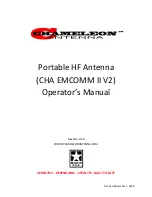
CHA EMCOMM II V2
Page 12
9.
Remove dirt from antenna components and inspect them for signs of wear.
10.
Store components together.
Troubleshooting
1.
Ensure Wire Connector is securely connected.
2.
Inspect Antenna Wire for breakage or signs of strain.
3.
Ensure UHF Plugs are securely tightened.
4.
Inspect Coaxial Cable assembly for cuts in insulation or exposed shielding. Replace if damaged.
5.
If still not operational, connect a Standing Wave Ratio (SWR) Power Meter and check SWR.
6.
If SWR is greater than 10:1, check antenna tuner or coupler using the technical manual or
manufacturer’
s procedure. Be sure to check the Coaxial Patch Cable that connects the radio set to
the antenna tuner or coupler.
7.
If still not operational, replace Coaxial Cable assembly.
Most problems with antenna systems are
caused by the coaxial cables and connectors.
8.
Connect a Multi-Meter to the Antenna Wire to check continuity. Replace assemblies that do not
pass a continuity check.
9.
If still not operational, replace Matching Transformer.
Specifications
•
Frequency: 1.8 MHz through 54.0 MHz continuous (including all Amateur Radio Service bands
160m to 6m). Wide range antenna tuner or coupler required.
•
Power: 250 W continuous duty cycle (CW, AM, FM, RTTY), 500 W intermittent duty cycle (SSB
and SSB-based digital modes)
•
SWR: Subject to frequency and configuration, see red (bottom) line in figure (6).
Figure 6. SWR vs Frequency Graph.
•
RF Connection: UHF Plug (PL-259)
•
Length: 60 ft (maximum) and around 35 ft (minimum)


































